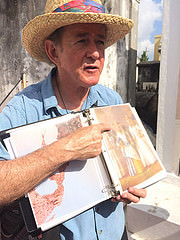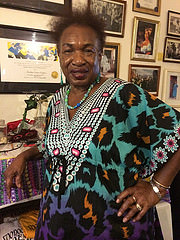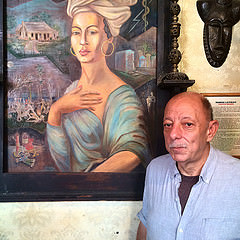by Neil Giardino
Tour guide Naif Shahady led a group recently through St. Louis Cemetery No. 1, New Orleans’s oldest necropolis located in the city’s Tremé neighborhood. Dating back to 1789, this Catholic Creole cemetery is said to contain the remains of more than 100,000. The deceased include French playboy Bernard de Marigny, famed for bringing craps to America, U.S Chess Champion Paul Morphy, and perhaps most notably, New Orleans “voodoo queen” Marie Laveau, a free woman of color who died in 1881.
The guide pointed to several conspicuous red X’s drawn on her tomb. “What you see right there, that’s grave desecration,” said Shahady, who leads tours for Save Our Cemeteries, a nonprofit that funds preservation efforts through guided tours of historic cemeteries. A common superstition compels visitors to mark three X’s on Laveau’s tomb and to leave offerings for her spirit. Neither Shahady nor Save Our Cemeteries find this folksy ritual amusing.

Tour guide Naif Shahady leads tours for Save Our Cemeteries, a nonprofit historic preservation group. Photo by Neil Giardino
“It’s a problem,” said Shahady, referring to the ubiquitous red etchings. “We’re spending thousands of dollars right now to renovate the tomb.”
While these ritual etchings might hint at a sustained curiosity in voodoo spiritual beliefs, a stroll through downtown reveals beyond any doubt that interest in voodoo – a collection of ancient African religious beliefs brought here by African slaves – is alive in New Orleans today. Dozens of thriving voodoo shops, temples, and museums – from Bourbon St. to Bywater – are testament to its surviving legacy.
The Voodoo Spiritual Temple
The Voodoo Spiritual Temple is housed in a creole cottage with peeling vanilla stucco on the French Quarter’s northern rim. Specializing in West African herbal healing practices, it was founded by Priestess Miriam Chamani, 71, of Jackson, Miss., who has maintained the temple and its adjoining herbal apothecary-cum-gift shop since 1995. She said discipline has given her focus.
“I have been dutifully in this spot and that must speak clear to people,” she said. “You have to have constructive order and be able to maintain wellness within yourself.”
Curious passersby entered her shop, and soon found themselves opening up to the Chamani. One client wanted to schedule a consultation within her temple later that week, another sought a potion to help a friend become pregnant.
Mojo beads, voodoo dolls, potions, oils, and herbs are sold here, but it is Chamani’s spiritual consultations that have made her a pillar within the voodoo community in New Orleans. The Priestess offers spiritual counsel much like a psychic would, helping clients exorcize struggles and hardships, as well embrace positive changes in career and relationship. Chamani’s slow and often-enigmatic speech makes visitors hang on to her every word. A cockroach scurried by her feet – still visitors listen with rapt attention. Her rates, much like her manner of speech, are cryptic, but generally seem to fall into a sliding scale.
In order to better understand Chamani and the Voodoo Spiritual Temple, an invitation into her temple is necessary. Through a beaded curtain and down a dark hallway adjacent to a lush courtyard is a dank and dimly lit room adorned with alters. Here Chamani communicates with voodoo deities.

Priestess Miriam Chamani has maintained the Voodoo Spiritual Temple since 1995. Photo by Neil Giardino
African masks, tattered dolls, bottles of rum, folded dollar bills, statues of Catholic saints, and packs of cigarettes are among an assortment of offerings to voodoo spirits. A muscular python sliding up the wall of its wire cage seems almost to receive callers of the temple. Here, Chamani’s spiritual practice becomes vivid.
She is aware that her culture’s many misinterpretations and erroneous beliefs about zombies and hexes are part of what bring people to her shop. She doesn’t mind the commercialization of voodoo in New Orleans, nor do the many misconceptions of her culture bother of her.
“If we eradicate all misconceptions of something, we wouldn’t be able to express or create other concepts,” she said. “So misconceptions are great.”
The Historic Voodoo Museum
There is one man in town who may disagree with Chamani on that point. Jerry Gandolfo traces his creole lineage in Downtown New Orleans back 300 years. Fatigued at first glance, he eased into a low-drawl lecture not only on voodoo, but also on New Orleans history. Since 2001 he has been the Administrator of the Historic Voodoo Museum located a half a block off Bourbon Street. The museum, like Chamani’s altar, is filled with voodoo dolls and Catholic statuettes. He also displayed portraits of Marie Laveau and human skulls adorned with coins and Mardi Gras beads.
Gandolfo says that voodoo is everywhere in New Orleans – and he isn’t referring to the dozen or so voodoo-themed curio shops. “That’s just voodoo Burger King,” he said, referring to one famous French Quarter voodoo shop. According to Gandolfo, the spiritual culture surrounding voodoo in New Orleans is alive today as much as it has ever been, though it tends to hide in plain sight.
“People have been so brainwashed by Hollywood, by the spooky stuff, that they don’t see it,” he said. He refers, in part, to its presence in the Catholic Church, where the concept of saints and spirits are analogous. But it goes beyond that, he said. It also deals with the veneration of relics and the likeness between voodoo and Catholic altars.

Jerry Gandolfo has been the Administrator of the Historic Voodoo Museum since 2001. Photo by Neil Giardino
When pressed to describe what voodoo actually represents in New Orleans, he offered this: “It’s multiple things, all of which are correct even though they’re contradictory. For some, it’s sort of a religion, for others it’s a superstition. Most commonly it’s folklore, and most publicly it’s ‘fakelore.’”
Gandolfo finds the preconceptions to be overwhelming, but he is careful not to disavow public preconceptions of voodoo – after all – that is what brings people through the door. “You’ve got to deal with it. I’ll add facts to the misconceptions,” he said.
Gandolfo contends most of the people who are monetizing voodoo in New Orleans are neither culturally nor ancestrally part of voodoo. Rather, their success is on account of good salesmanship.
“You’re not gonna go to Kansas City and make money off voodoo, so they come here. I think one used to be a Kabbalist and you know, that’s not voodoo,” he said.
Above all, Gandolfo emphasized that voodoo is a lifestyle and a culture, not a practice. There is no distinction between religion and recreation, no separation of the sacred and the secular.
“I try to tell what voodoo really is and avoid the more popular image of voodoo, which may be stupid because that’s what sells and I’ve got to pay rent like everyone else,” he said with a trace of a smile.
Island of Salvation Botanica
Among the voodooists who have built a formidable reputation in New Orleans is Sallie Ann Glassman. Ordained in 1995 in Haiti, Glassman, 60, of Maine, practices voodoo at the Island of Salvation Botanica in the Marigny neighborhood. She is a mambo asogwe, or high priestess of voodoo, a rare title for a white American. Glassman offers spiritual counsel and readings at her shop within the New Orleans Healing Center.
“I try to keep my prices really low because I know that a lot of people don’t have access to psychiatric care,” she said. “I want it to available and meaningful to everybody.”
Glassman said that clients pretty much run the gamut – from anthropologists and students, to psychiatrists and those attempting to retrieve fragments of memory. Above all, said Glassman, voodoo is about understanding the immortal soul. “Mostly, I think voodoo is about healing on all levels and about finding balance and wholeness,” she said.
Glassman, who has been referred to as the “new voodoo queen” of New Orleans, said she is leery of titles like these.
“I’m Jewish, so I always say that I’m a Voodoo American Princess, instead of a Jewish American Princess. I hope that way the other voodoo priestesses who are certainly worth the equal respect don’t come and lynch me,” she said with a laugh.
Glassman finds the hostility within the voodoo community to be irritating, but she disassociates from it.
“I think that those of us who’ve been here for a while are trying to improve social conditions in New Orleans, so there’s a great deal of respect amongst one another,” she said.
Glassman added that voodoo is at the backbone of the city’s culture. During the aftermath of Hurricane Katrina it provided the strength and resilience many needed to survive. “I think voodoo is definitely part of this city in overt and subtle ways.”
Glassman, like Priestess Miriam Chamani, Voodoo Scholar Jerry Gandolfo, Marie Laveau, and the thousands whose daily rituals are informed by voodoo, have each indelibly shaped contemporary voodoo culture in New Orleans.
As Gandolofo noted, “Voodoo is everywhere, but sometimes people don’t recognize it when it’s right in their faces.”
Voodoo from Pavement Pieces on Vimeo.
